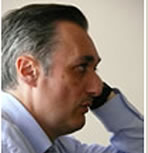
M ° Antonio Juvarra
VOICE TECHNIQUE ACCORDING TO ITALIAN TRADITION
(Singing natural)
The essence of singing, however threatened (as always happens to real and precious things), from ignorance and tampering, it still resounds in our days in the places where its apparition is given to us… Grasping behind its magic the secret that makes it possible is the challenge that pushes many in its path. There is an Italian way, recognized worldwide as the most valid, to reach this goal. It was born from that incredible intuition from which all classical Mediterranean art was born, or: only what is profoundly simple and natural can express and accomplish what is authentically beautiful and human.
'Natural singing’ it is the principle elaborated for the first time by the greatest treatise writer of the bel canto period, the eighteenth-century Mancini, alluding to that particular vocality, which will later become known all over the world as' Italian song’ or 'belcanto'. We find this same expression surprisingly in the writings of vocal technique, left by three of the greatest tenors of the twentieth century, Enrico Caruso, Aureliano Pertile and Giacomo Lauri Volpi.
'Natural singing', so. It would seem a trivial and indefinite formula, as always happens with great truths. It is obviously not intended as a "sing as it comes to you", but as a gradually becoming aware of the two levels of naturalness that always act in us and combining them together: the superficial nature and the deep nature, that, as Heraclitus had already discovered, loves to hide….Arrived at this awareness, you get to understand what Bacon meant, when he stated: “Only by obeying nature, it is commanded. ”This principle governs all disciplines of the body at a high level: from Italian singing to judo, to Japanese karate and aikido. They all share the same intuition: there is hard energy, heavy, muscular, based on direct mechanical control of the muscles (typical of all forms of pushed and shouted singing) and there is a sweet energy, impalpable, widespread, the result of a soft and holistic approach to vocality and which characterizes that supreme form of singing that we call 'belcanto'. In fact, it is a matter of letting it work’ and not a 'make it work', and 'letting it work’ it is obviously a date of arrival and not of departure.
In order not to remain vague and generic, you could see more precisely what this naturalness is made up of, which we can define as second degree, since it is only minimally a starting point. The nature to draw from so that the true song makes its appearance, it is twofold, that is, the components of this recipe are two:
1)- TOTAL BREATH (deep nature) 2)- SPOKEN (superficial nature). This is based on the well-known aphorism of Farinelli from the second half of the eighteenth century, Pacchierotti, which says so: “Who knows how to spell and breathe well, will know how to sing.”
More precisely, the chemical formula of bel canto could be defined in the following way : TWO ATOMS OF BREATH, AN ATOM OF SPEECH.
Obviously for 'two atoms of breath’ it does not refer to the amount of breath, but to the quality and extended breadth of inspiration, different from that of the spoken voice, the latter just as natural, but more superficial and unconscious. Similarly for 'a speech atom’ it is understood that speech must remain pure and simple 'say’ and not turn into 'declaimed', as often happens. In this case the 'speech’ represents the superficial nature, already given, while the 'breath’ represents the deep dimension of the sigh of relief and the breath of air.
The reason why who speaks very well, then instead he sings terribly, is the following: SPEECH IS TRANSFIGURED INTO SINGING ONLY THANKS TO TRUE BREATH, OTHERWISE IT REMAINS SIMPLE TUNED SPOKEN. SAID IN ANOTHER WAY, THE SPEECH AND’ THE FIRST WING OF THE SONG, BUT ONLY WITH THE SECOND WING, THE BREATH, LANGUAGE’ TAKE FLIGHT AND BECOME A SINGING.
Second precaution to follow when applying this recipe: since it is spoken’ and breath’ they are two opposites, one representing the core of sound, the other the space that makes it resonate, one element tends to crush the other. The vocal technique is nothing more than the patient search for that right dosage, of that right balance that only allows the two components to merge and give rise to something, precisely belcanto or 'verocanto', that, as the holistic disciplines teach, is greater than their sum.